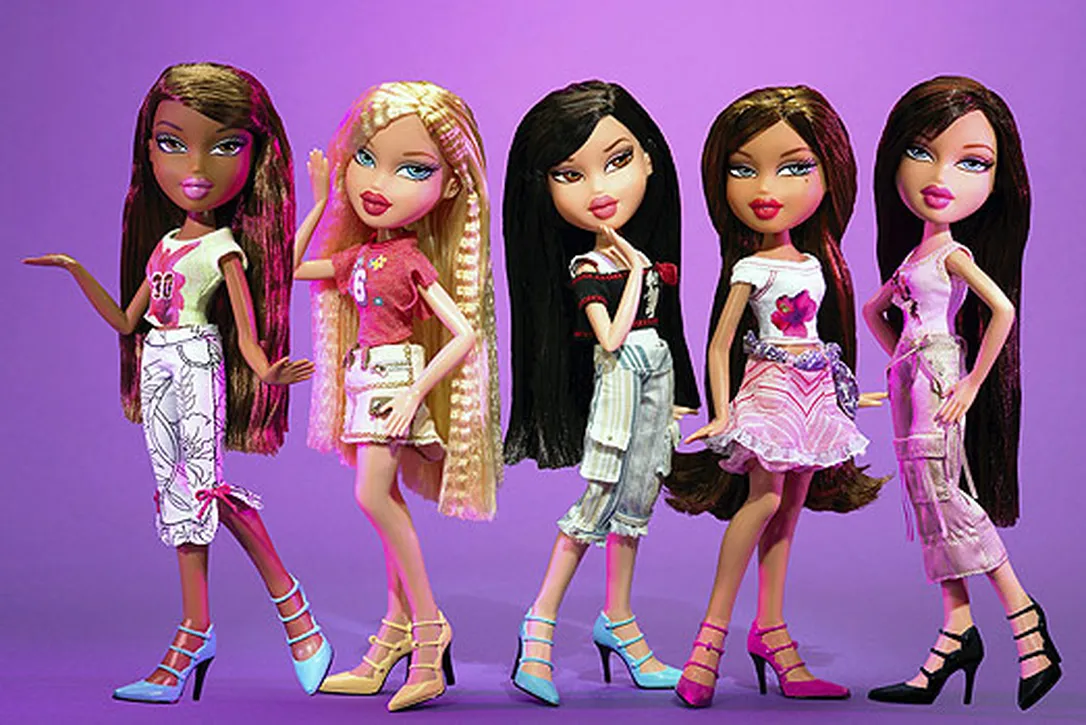MGA Entertainment’s Bratz are the alarmingly progressive younger sibling of Mattel’s Barbie. The Bratz have a freedom and audacity that is unique to younger children, a quality that earned the dolls a cult following and a recent revival in popular culture. Whereas Barbie has become a concept more than a doll, the Bratz have never been anything other than themselves. For better, and most certainly, for worse.
For a long time in the doll world, there was only ever Barbie. The iconic Mattel creation was a pioneer in the industry — creator Ruth Handler wanted to show young girls that they could be more than just caregivers and mothers. They could be women with careers. Released in 1959, Barbie was every little girl’s idol: an astronaut, a model, a girlfriend, an ally, but always a blonde. She perfectly captured the zeitgeist of mid-century America and its blind spot for little girls of color; Barbie can be anyone she wants, but not everyone can be Barbie.
20 years after her first iteration, Barbie attempted her greatest feat yet — true representation. Though Mattel had previously made diverse dolls, they were merely friends of Barbie’s. The first Black and Hispanic dolls named Barbie were released in 1980, though after 20 years of marketing blonde Barbie to every girl, the release felt contrived. Barbie is forever immortalized as the 11-inch-tall blonde career woman that Mattel first introduced.
The Bratz clearly learned the significance of character from their predecessor. MGA Entertainment struck gold with their original four Bratz dolls. Each girl has a distinct look and sense of style, or “fashion-passion,” that appeal to almost anyone. Beyond that, the girls are diverse:
Yasmin, also called “Pretty Princess” by the other girls, is Latin American with a fashion-passion for Bohemian style clothes.
Sasha, also known as “Bunny Boo” is African American with a fashion-passion for urban streetwear.
Cloe, also called “Angel” is the only white doll and has a fashion-passion for animal prints and sparkly fabrics.
Jade, or “Kool Kat” is Asian American with a fashion-passion for clothes that are “far out”.
The Bratz dolls sell an aesthetic that heavily incorporates their ethnic backgrounds and features. The girls are easily recognized by their large eyes and even larger lips set delicately on a head that is anatomically impossible. Each doll has a unique makeup look to supplement her outfit complete with snap-on feet and shoes that bring the entire look together. For children’s toys, the attention to detail may feel like overkill. Many parents felt the outfits were too adult, too skimpy, but their experimental fashion is what drew many consumers to the Bratz. MGA Entertainment’s emphasis on their look may seem vapid, but like Barbie, the Bratz are career women. Their business is all things fashion. The look and style is, of course, a main driver in the Bratz’ current resurgence. Some companies such as DollsKill have done direct collaborations with Bratz, but many of the girls’ staple looks, such as their chunky boots and Y2K-inspired attire, remain present in the real fashion world. Their animated series and movies have developed this passion for fashion into a career with the introduction of “Bratz Magazine.”
Beyond their style, a large part of the Bratz’ appeal lies in their friendship. Barbie can’t help but be considered a solo act– her boyfriend Ken is little more than an accessory and her younger sisters Stacie, Skipper and Chelsea are infrequent presences in Barbie’s narrative. Barbie’s selling point is her career, or rather, careers. After over half a century of consistent releases of Barbie dolls, she remains the sole face of her empire. The Bratz, on the other hand, were introduced as a unit. Even with their wildly different senses of style, the four girls are connected in their boldness and their love for fashion. The animated series plays off their friendship dynamics and the live-action movie adds further complexity to their relationships. Viewers get to see a different, brattier side of the girls that parents may resent but children find solace in.
In this way, Barbie fails — she’s an ideal. Barbie is a woman who has accomplished every dream a person can have, with no flyaways and no failures. While she is something for young girls to strive for, she has never actually been attainable. The Bratz aren’t perfect — they are a group of flawed individuals who viewers can relate to. Their blunders are comical but relatable — a regrettable insult, a faux pas in class — yet their friendship prevails. The Bratz demonstrate that while their passion for fashion is enviable, their strength comes from their connection to one another. This framework of the Bratz as a unit, rather than a single doll also allowed for their seamless expansion. By 2006, MGA Entertainment released Lil’ Bratz, Bratz Kidz and Bratz Babyz.
The Bratz were, to put it simply, ahead of their time. With diversity and passion embedded in their essence, the Bratz had the freedom to push the boundaries of what it meant to be a doll. In 2001, the world was only accustomed to Barbie and her desire to push little girls to find their voice in what was already known. The Bratz aimed to create, and over 20 years after the first four girls were released, the world is truly starting to appreciate the girls with a passion for fashion.

















